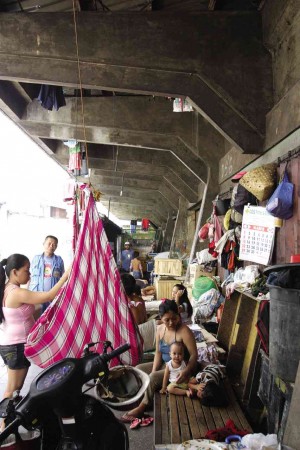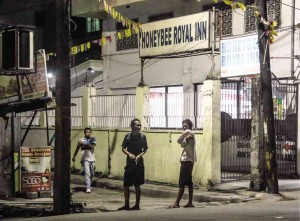Kamagayan: Cebu City’s dark side

A COMMUNITY of homeless families mushrooms on the perimeter of Citi Center Complex in Barangay Kamagayan in Cebu City, tagged as the city’s red-light district and known for rampant drug use and sale. JUNJIE MENDOZA/CEBU DAILY NEWS
CEBU CITY—Myrna was 18 when she came to Cebu from her home province in Leyte in 1985 in search of a job.
She found one as a salesgirl in a store in downtown Cebu City, but the pay was barely enough for her parents in Leyte.
She ended up working as a prostitute in Barangay Kamagayan, the city’s red-light district.
“It was an easy job. I was young and I had a lot of responsibility. [By being a sex worker], I was able to earn more,” she said.
Barangay Kamagayan is in the city’s Central Business District, a block away from Colon Street, the country’s oldest street.
Article continues after this advertisementAcross Kamagayan is the main campus of the University of San Carlos, one of the biggest and oldest universities in the city.
Article continues after this advertisementThe village is about a kilometer from the Central Visayas offices of the Philippine National Police and the Philippine Drug Enforcement Agency (PDEA). It is about 3 km from City Hall.
The short distance of the village from law enforcement and government offices, however, does not deter prostitution and illegal drug trade, which are rampant in Kamagayan. It is on the list of the top 10 drug-prone villages in the city’s 80 villages.
There are now calls for authorities to clean up the red-light district.
“A city that prides itself on its cultural heritage and religious monuments, on one hand, cannot on the other hand go on turning a blind eye on promiscuity and widespread drug abuse that are in our midst,” said Councilor James Cuenco, chair of the city council’s tourism committee.
“How can we not see the unabated illegal activities in Kamagayan happening right under our noses?” he said.
Celestino Avila, village councilor of Kamagayan, admitted that prostitution and drugs were rampant in his village.
“Kamagayan is the heart of the city. This is the center of everything,” said Avila, who had been village chief for nine years.
“But the people involved in drugs and prostitution are not really from Kamagayan. Most of them came from other provinces and ended up here,” Avila said.
The sex trade flourishes in Barangay Kamagayan because of its network.
At sundown, male pimps loiter in the village to wait for customers who come on board private vehicles or taxis.
Pimps negotiate with the customers. They get half of the agreed payment for the prostitutes’ services.
Victor, a hog dealer from Masbate province, said he would normally drop by Kamagayan whenever he was in Cebu, which is at least once a month. His purpose: to buy drugs and to hire the services of a sex worker.
He said his P1,000 could pay the services of a sex worker, rent a room inside the old Citi Center Complex and buy either a vial of Nubain, a regulated but abused injectable pain killer, or a sachet of shabu.
Citi Center Complex, which is about 7,000 square meters in area, used to be privately owned. Stalls were built inside, which were supposed to be rented to vendors.
The stalls, however, were closed down in 2000 when the vendors failed to pay rent. In 2004, the entire complex was forfeited in favor of the city government after its owners failed to pay taxes.
Community rising
Since no one was occupying the center, urban poor families and even those from other provinces started to settle in and live there.
Over the years, the city complex has turned into a center of sex and drug trade. Sex workers live in makeshift rooms.

TWO PIMPS on the lookout for customers are a common sight in Barangay Kamagayan, where sex and drug trades flourish right under the noses of law enforcers. The list of solutions is growing long, but implementation is nowhere in sight. CHOY ROMANO
Among them is Myrna, who transferred to Citi Center Complex from a boarding house.
She said sex workers like her would spend four to six hours each night waiting for customers. Pimps would bring three to four customers a night.
Although now 47 years old, Myrna continues to work in the flesh trade, acknowledging her age has forced her to accept smaller payments.
She said that sometimes, she gets only P30 to do a “hand job.” But if customers are hard to come by, Myrna accepts laundry work.
“If I could, I would want to go home,” she said. “I don’t know where to go. When I go back to Leyte, I don’t know if my family is still there,” said Myrna who doesn’t have children and remains unmarried.
Drug users also frequent Kamagayan to buy Nubain and shabu. Some rent rooms at Citi Center Complex where they consume the drugs.
Lawyer Mauro Licen, PDEA Central Visayas legal officer, said illegal drugs were rampant in Barangay Kamagayan because of the village’s location.
“These drug users and dealers occupy shanties and they are building a community that has their own alarm system,” he said. “So it’s really hard to penetrate. The suspects are hard to capture,” he added.
Another reason authorities are having difficulty shutting the illegal business down is the involvement of minors.
Children are being used as drug couriers as confirmed by the arrest on July 7 of two girls—ages 15 and 13—in a buy-bust operation. They were caught selling Nubain.
Since they are minors, the girls had been turned over to the Department of Social Welfare and Development.
“That’s really our setback,” said Senior Supt. Conrado Capa, regional police deputy director for operations.
Search for solutions
Councilor Cuenco asked the police and the military to set up checkpoints against the transport of drugs.
He also recommended the installation of closed-circuit television cameras around the area.
His colleagues in the city council, however, opposed the proposals, saying they could violate the rights of other residents in the area who have nothing to do with illegal activities there.
“There are also many decent residents in the barangay,” said Councilor Sisinio Andales.
Vice Mayor Edgar Labella, head of the city’s Police Coordinating and Advisory Council, said City Hall wanted to demolish the Citi Center stalls and develop the area into a housing site for city employees and qualified occupants.
“The planned development is expected to get rid of illegal activities that now flourish in the area and hopefully get rid of the bad image of Barangay Kamagayan,” he said.
But the city is still looking for funds for the project.
Avila admitted that clearing Citi Center Complex would be the best way to stop illegal activities there.
At least 300 residents of the complex filed a petition in court to stop their eviction unless the city gives them a relocation site. The local court dismissed the petition in June 2013.
Collin Rosell, head of the city’s Department for the Welfare of the Urban Poor, said an eviction notice was issued in July to 96 families occupying Citi Center.
After the complex is demolished, he said illegal settlers who qualify for relocation would be allowed to build temporary structures in the area until the housing project for them and city government employees is finished.